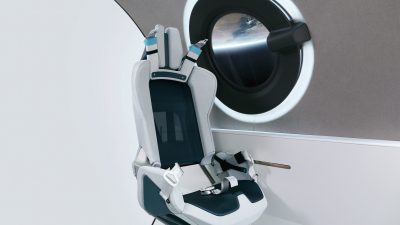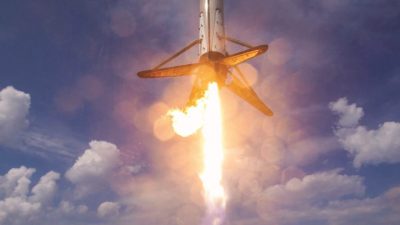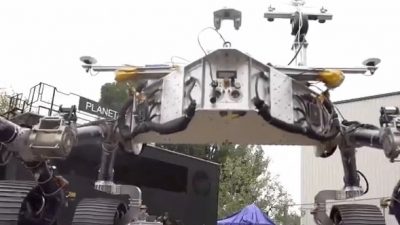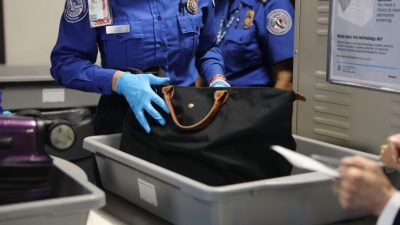Moon patrols could be a future reality for the U.S. military
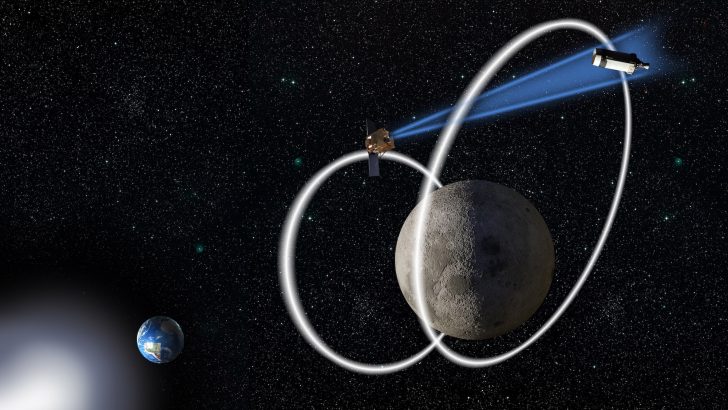
U.S. military space activities today are confined to Earth orbit. That could change in the coming years as NASA begins to establish a permanent presence at the moon and works with the private sector to develop a cislunar economy. The military foresees playing a role protecting those interests if they were challenged by a foreign power.
The Space Force echoes that thinking in a doctrine document published in August, which says the service must prepare for a future when the moon and the volume of space around it could become the next military frontier.
The Pentagon made known its interest in deep space in spring 2019, when then-director of the Space Development Agency Fred Kennedy revealed that tracking objects in the lunar sphere was on the agency’s priority list.
A key development last month was the announcement by the Air Force Research Laboratory’s Space Vehicles Directorate that it will embark on an experiment to investigate technologies to monitor cislunar space.
“It’s a brave new world for the DoD to embark on,” said Capt. David Buehler, manager of the AFRL experiment named CHPS, for Cislunar Highway Patrol System.
The U.S. Space Force is contemplating a time when its responsibilities could extend beyond geostationary Earth orbit, Buehler told SpaceNews.
“If we’re going to protect and defend, the Space Force is going to need to understand the environment, have space domain awareness capabilities to be able to know where everything is out there,” Buehler said.
“I think our experiment is extremely groundbreaking,” he said. “This could be the first mission for DoD going beyond GEO.”
Buehler said the details of the experiment are nowhere close to being decided. AFRL plans to solicit ideas from the private sector and assess different technologies and approaches, he said. The Space Vehicles Directorate plans to host a conference for interested contractors sometime in 2021 at Kirtland Air Force Base, New Mexico, but the timing will depend on the coronavirus situation, Buehler said.
Scientists widely agree that the surveillance of cislunar space presents daunting technical challenges, he said. One of them is estimating the trajectory of objects that are subject to both the Earth’s and the moon’s gravitational effects, said Buehler. “As you go further and further beyond GEO, you start to have these weird, non-closed trajectories, they no longer look like orbits, they’re more open-ended trajectories.”
And the distances are mind-boggling, he added. “We have 1,000 times more volume to surveil. The space after the moon and beyond is 1,000 times larger, so you’re dealing with an enormous amount of volume.”
The brightness of the moon also creates obstacles for sensors. “And that’s one of the things we’re hoping to overcome with CHPS,” Buehler said. “If you can get out near the moon, you can start to beat down some of those brightness challenges.”
As the project moves forward, AFRL will seek advice from the Space Development Agency, the Space and Missile Systems Center, and NASA. “We’re looking to actively partner with NASA wherever we can,” said Buehler. “Obviously, they have the expertise operating far beyond GEO that DoD just does not have.”
A recent cooperative agreement signed by the U.S. Space Force and NASA lays the groundwork for future collaboration on cislunar space surveillance.
Maj. Gen. John Shaw, commander of space operations at U.S. Space Command, called cislunar space surveillance a “big-data problem.”
“It’s going to require many, many sensors and the fusion of data to present a picture, and predictive analytics to deliver an idea of what’s going on in the lunar sphere,” Shaw said on a webinar hosted by the California Polytechnic State University.
“When you do the math, it’s a huge volume,” said Shaw. “In the military we talk about the tyranny of distance across the oceans. This is about the tyranny of volume.”
Just understanding what’s happening in the environment will be hard, said Shaw, “And that’s if people are not up to mischief. Once you have threats introduced into that environment, it is even more challenging.”
Role of private sector
The CHPS experiment will provide a glimpse into how DoD plans to leverage technology from the private sector. “It’s exciting to see that we might even open up the commercial market with what we’re doing,” said Buehler. “Until the government shows interest, businesses aren’t going to invest.”
U.S. commercial companies are developing deep space technologies previously exclusively reserved for governments, from communications to navigation to lunar landing systems, said Doug Hendrix, CEO of ExoAnalytic Solutions, a firm that operates a large network of optical telescopes to track objects in orbit.
Space domain awareness technologies are a “foundational component of the infrastructure needed to support a cislunar economy,” Hendrix said.
“For us, the telescopes looking at geosynchronous orbit are the beginning of a larger vision,” he said.
ExoAnalytic currently has contracts from AFRL and from the Space Development Agency to demonstrate capabilities to track objects in cislunar space, and to figure out the components of a space-based architecture to do cislunar surveillance.
One of the issues the company is examining is where to put satellites and what sensors would be needed to monitor space from the Earth out to the moon and even farther, said Hendrix.
“There are different orbit designs to come after those challenges,” he said. “We’re in the early phases of the study.”
Most of the objects transiting today in cislunar space are research satellites and scientific probes. “So right now there are very few objects. But there’s a lot of commercial as well as sovereign nations’ interest in exploring the moon and creating maybe a permanent presence,” said Hendrix. “The Chinese are definitely on the path to creating a permanent presence. The United States plans to do so.”
With the ground-based sensors available today, it’s possible to track medium-sized to larger satellites all the way out to lunar range, said Hendrix. “Cislunar is 10 times the range of GEO, objects are going to be 100 times dimmer. And it’s 1,000 times the volume to surveil.”
“We have been developing the technology for at least the last five years specifically to be able to see as dim an object as possible, which translates to being able to see farther,” he said. “The same technologies we’ve developed to see very small objects in Earth orbit allow us to see farther out into the lunar orbit.”
Major investments will be needed in communications and navigation systems for cislunar space, said Hendrix. “We would like to see the U.S. government pay serious attention to this.”
He said DoD has an opportunity with cislunar efforts to embrace new ways of working with the private sector. “These efforts will require rapid innovation,” Hendrix added.
The U.S. government is now working to transition the responsibilities of space traffic management from Defense to the Commerce Department, he noted. “I’m really looking to see how they are going to expand these plans to include cislunar as that traffic grows.”
Source: SpaceNews

